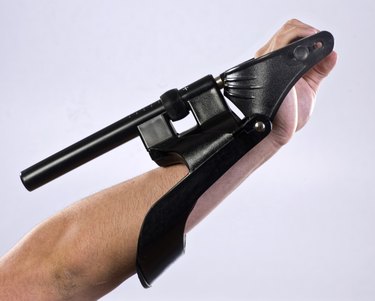
In the bodybuilding world, a well-known maxim is that strength comes before size. To build muscle, strengthening will have to come first. This fact applies to all muscles, including those of the calves, legs, chest, arms and especially forearms. Unlike other muscles of the body, the forearm muscles usually take longer to grow in size. The exact time frame it takes to develop your forearms, of course, will vary widely depending on factors, like your specific goals, training regimen and self-discipline. With proper resistance training, however, you should begin to see some results within a few weeks, according to the University of New Mexico.
Forearm Muscles
Video of the Day
The brachialis, brachioradialis and pronator teres muscles are the major muscle groups of the forearm. However, these muscles do not have the same capacity for growth as do the larger muscles because of a structure differential. Generally, longer, leaner muscles do not have the same ability to be packed with mass as the more compact muscles. Therefore, it will likely take more work and time to build them.
Video of the Day
Hand Grips
Most department or fitness supply stores offer special hand grips that are designed specifically to help strengthen and develop your forearms by squeezing the grips together with one hand. The available resistances for these grips can vary widely, allowing you to continue challenging yourself as your forearms grow stronger. Some individuals use light resistance grips as a warmup before a more intense routine, while others use heavy resistance grips as a major component of the routine itself.
Weight Training
You also can perform a variety of resistance training exercises with a barbell or a pair of dumbbells to help build your forearm muscles. For example, holding a weight with a reverse grip, that is your palms facing down, and performing a curl motion can help strengthen the muscles on the back of your forearms. Holding a weight with your arms at your sides, then curling your hands up towards your elbows while leaving the rest of your arms stationary can help strengthen the muscles on the front of your forearms.
Recovery
Simply performing resistance exercises is not sufficient to build muscles. You also must allow your body to recover properly. Mass comes with the right balance of rest, diet and training. For example, getting at least seven hours of sleep a night is imperative for muscle growth. You also must ensure that your diet contains a balanced blend of all major and minor nutrients. Finally, you must allow your forearms time to heal after you work them out. Use these rest periods as opportunities to train other parts of your body.